Despite our several travels over the years, Bev, Zen, and I never tire of this amazing area. When looking back at the many things we love about Tuscany, parts of rural Japan, and northern California, we always return to aesthetic perfection — our beloved Provence! The area’s culture, art scene, compelling history, and dining are almost unparalleled in scope and dearth. For this reason, we consider it more than a region, but a way of life. Provence carries with it the sound of cicadas, the scent of pine on warm breezes, and the slow rhythm of days shaped by seasons and sunlight. Vincent Van Gogh shared a similar affinity for Provence, even connecting the southern city of Arles to the beauty and mystique of our other beloved destination, Japan, in a letter to his brother Theo.
“…I always think that what we need is sunshine and fine weather and blue air as the most dependable remedy. The weather’s still fine here, and if it was always like that it would be better than the painters’ paradise, it would be Japan altogether.” – Vincent Van Gogh, 1888.
Provence contrasts the glamour of the French Riviera with its quieter (yet no less luxurious!) rugged timelessness and natural elegance. While no strict borders define it, you know instantly when you’ve arrived thanks to its deep sense of place: picture rolling hills lined with olive groves and vineyards, and hilltop villages perched on rocky ledges. And, being among the largest rosé-producing regions in the world, its landscapes pair perfectly with a glass of something pale, crisp, and chilled.
Among our most enjoyable summer retreats is visiting the many hill towns, villages, and cities of the idyllic Provence-Alpes-Côte d’Azur. We are grateful to use a handful of skilled local private guides. Having a knowledgeable local guide/driver alleviates any travel stress, creating a relaxing experience in a region that consistently displays an enlightening tableau worthy of Impressionist painters and culturally engaging travelers.
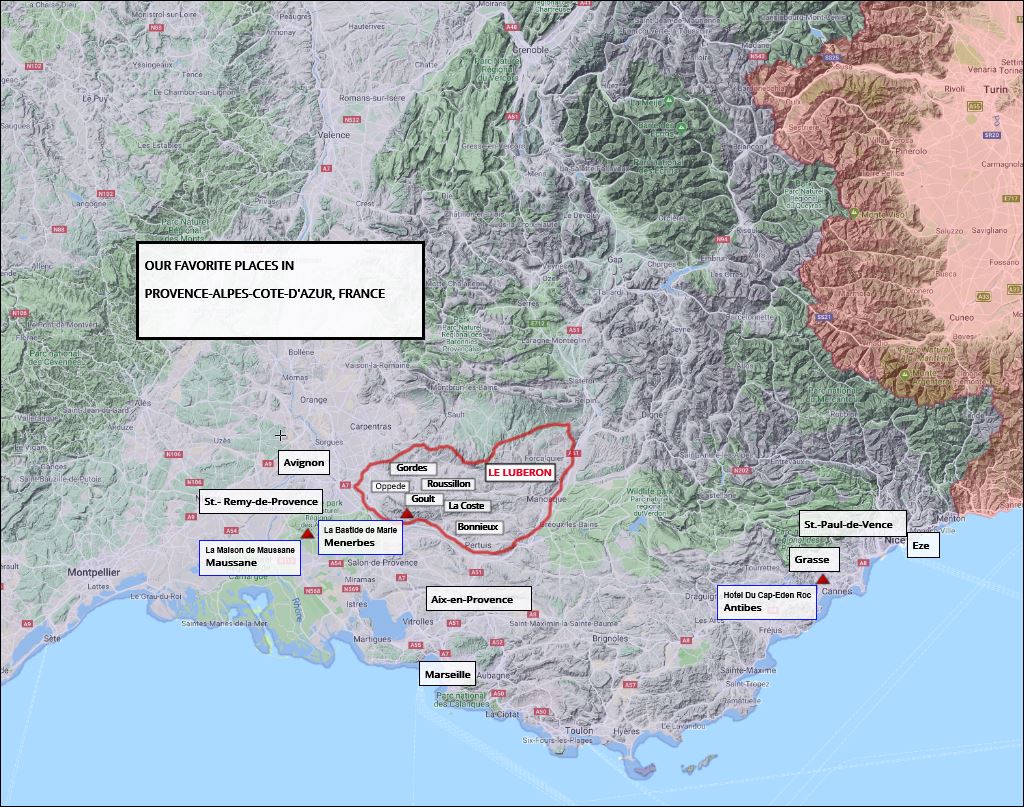
Luberon
An hour’s drive from Aix-en-Provence, Luberon spans 231 square miles and boasts mountain ranges, vineyards, and orchards throughout its landscape. The heart of this massif is the villages that make up its “Golden Triangle” — namely, Bonnieux, Gordes, Goult, Lacoste, Oppède, Roussillon, Saint-Rémy-de-Provence, Fontaine-de-Vaucluse, and Ménerbes.
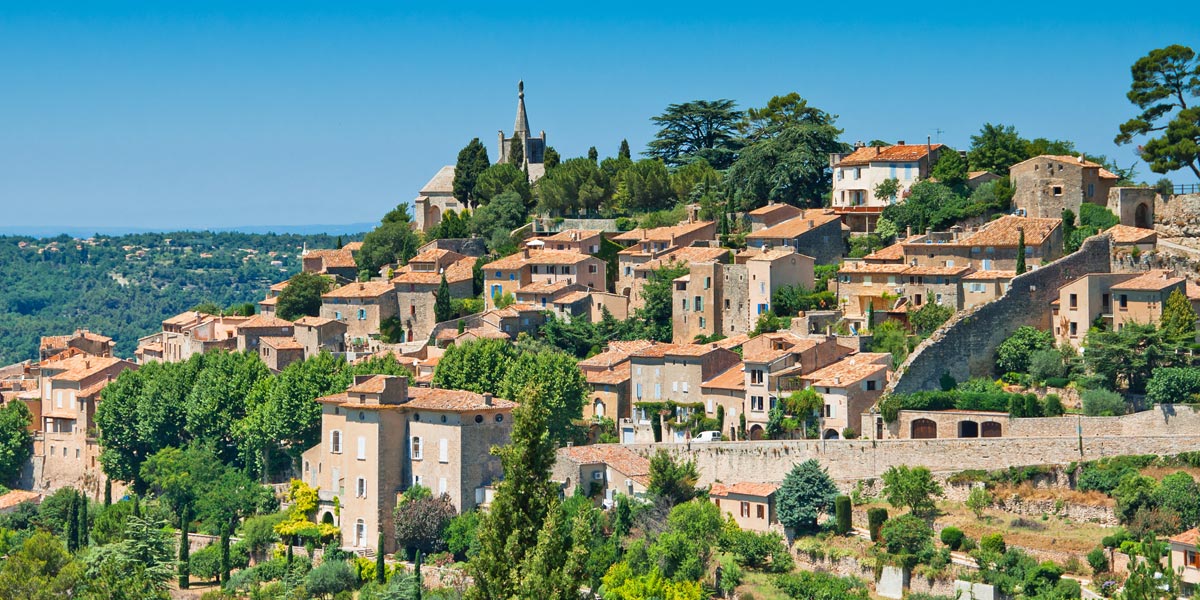
Bonnieux
Similar to other Provence hilltop villages, Bonnieux offers great views across the valley floor with its patchwork of orchids and vineyards. We feel the 12th-century Roman-Gothic Church “Vielle Eglise” at the top of the village is particularly interesting. We were lucky to visit Bonnieux on a Friday during our last trip to Provence. Friday morning is market day at the bottom of the village — many fun local crafts and delicious fruit!
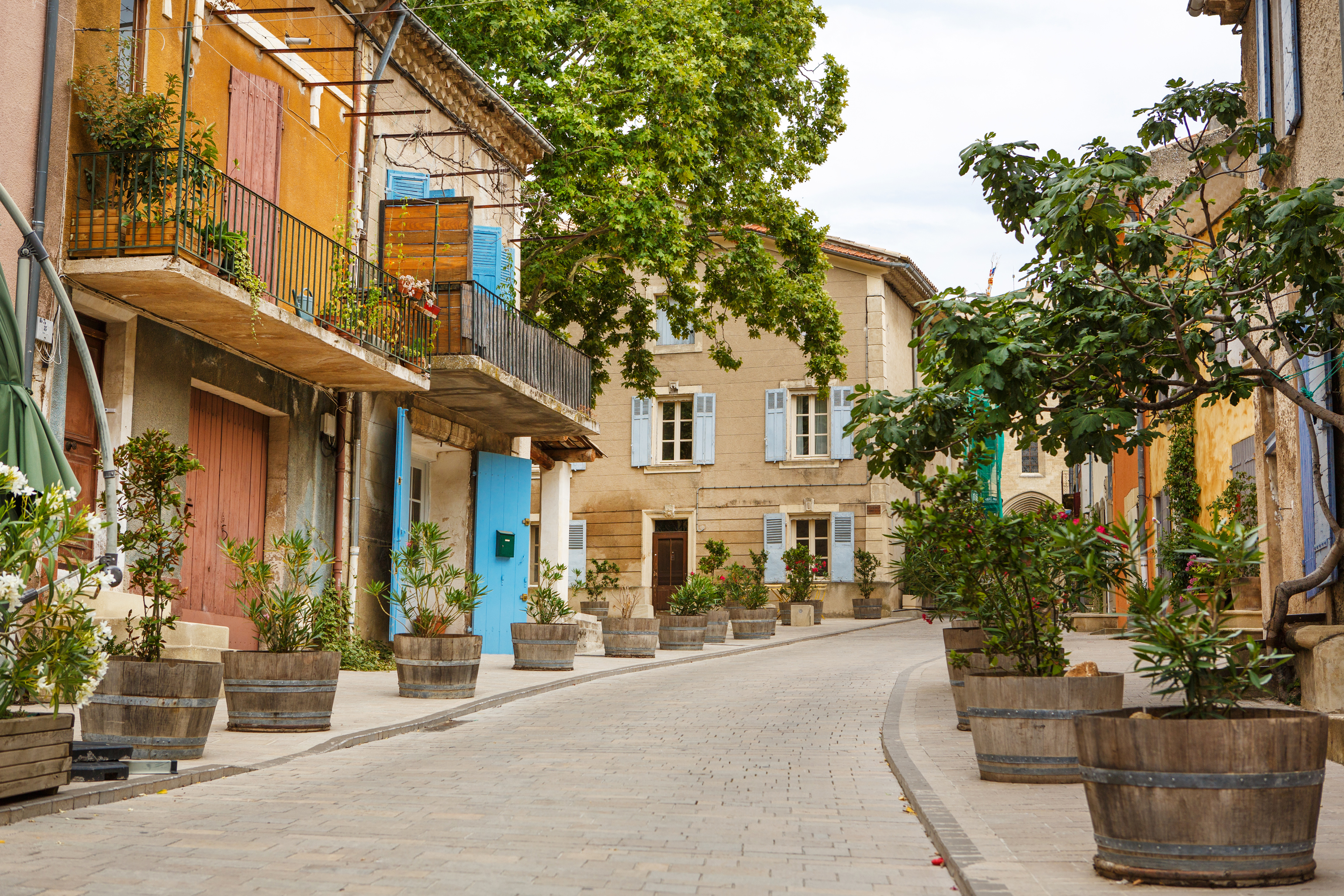
Saint-Rémy-de-Provence
Stylish Saint-Rémy is our favorite location in the Luberon area for wide-ranging shopping and many wonderful dining options. Originally home to Nostradamus, you see many noteworthy transplants and their Lamborghini’s and Ferrari’s parked throughout the streets! We enthusiastically suggest an excursion to nearby Glanum, the Greek and Roman archaeological ruins dating back to 30th century BC. Much of this ancient city’s ruins are still intact, a former thriving city complete with baths, forums, marketplaces, temples, and houses.

Fontaine-de-Vaucluse
Among our favorite lunch stopover points in Provence, the quaint riverside village of Fontaine-de-Vaucluse is the source of the River Sorgue. Luckily, if visiting in the spring (April, in particular) the melting water originating from the subterranean passageways turns the river water to an amazing azure green. Trout lunch at the riverfront Restaurant Philip 1926 makes for a relaxing and delicious afternoon!
Lacoste
One of Luberon’s communes, Lacoste is the site of the Marquis de Sade’s castle. Particularly notable is the annual Festival d’Avignon, which takes place in July and showcases world-class opera and concerts against the backdrop of the 15th-century castle.
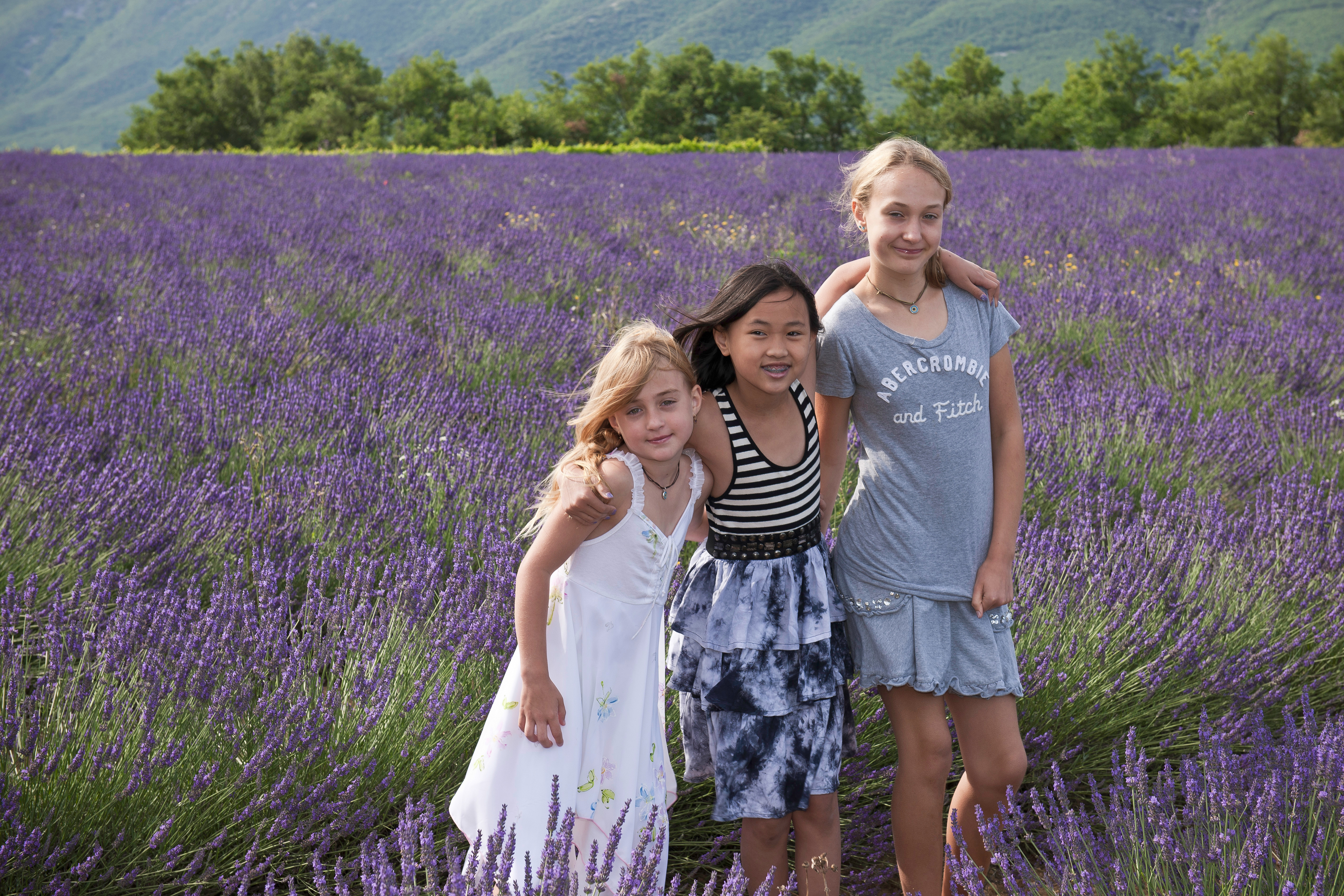
Gordes
In our opinion, no town captures the spirit of Provence more than Gordes. Just over 90 miles from Saint-Tropez, it embodies “hyper-relaxed” sophistication. Perched villages abound in Provence, but Gordes is said to attract the most visitors. On an escarpment of the Vaucluse Mountains, it is dominated by a 16th-century Chateau perched above massed houses and almond trees. In a wild valley north of Gordes stands the beautiful 12th century Abbey of Sénanque. In 1969, its Cistercian monks moved to the island of St. Honorat, off the shore of Cannes and the admirably preserved buildings are now a cultural center. Still home to an active community of a mere 6 monks, the church here is open to visitors for day tours and spiritual retreats except during peak Lavender blossoming season in June.
Gordes is famous for its stunning Lavender Route—a wide blue-purple swath that connects over two thousand producers across the Drôme, the Plateau de Vaucluse, and the Alpes-de-Haute-Provence. You will discover the tiny flower which is described as the “Soul of the Provence.”
This was a big nature highlight for Zen as she finally had an opportunity to enjoy the sights and smells of the amazing lavender fields. Many consider the end of June to be the best time to discover the French lavender Fields as this is the precise time when the flowers are in bloom in the Drôme Provençale. Local perfumers and makers of bath and body products judge the countryside around Sault to be at the heart of the very finest blue lavenders of France.
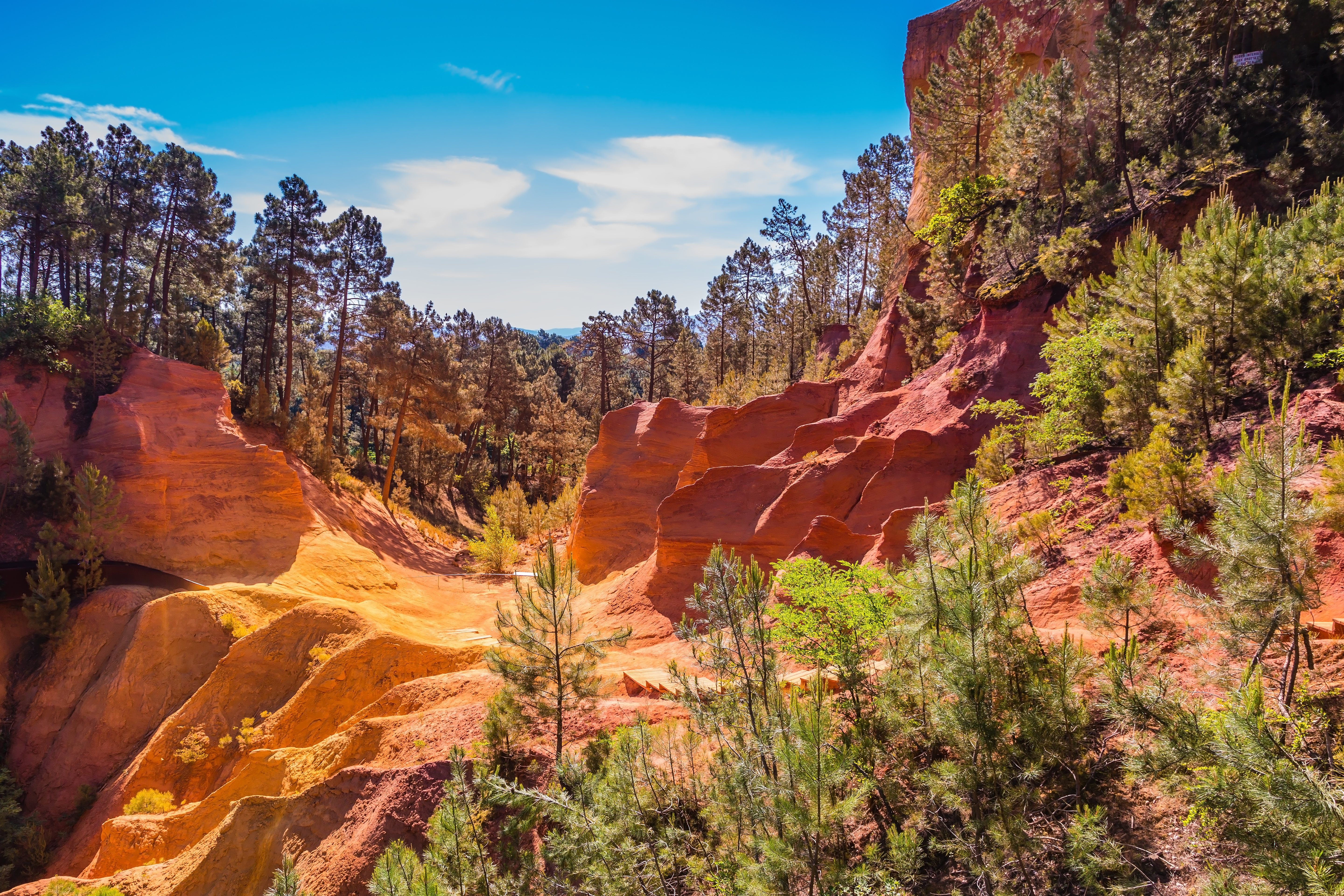
Roussillon
Another town of the Luberon, Roussillon is known for its red, ochre earth. The earthy shades are contrasted with lush foliage and blue sky making for an excellent stopover on your tour of Provence.
Villages
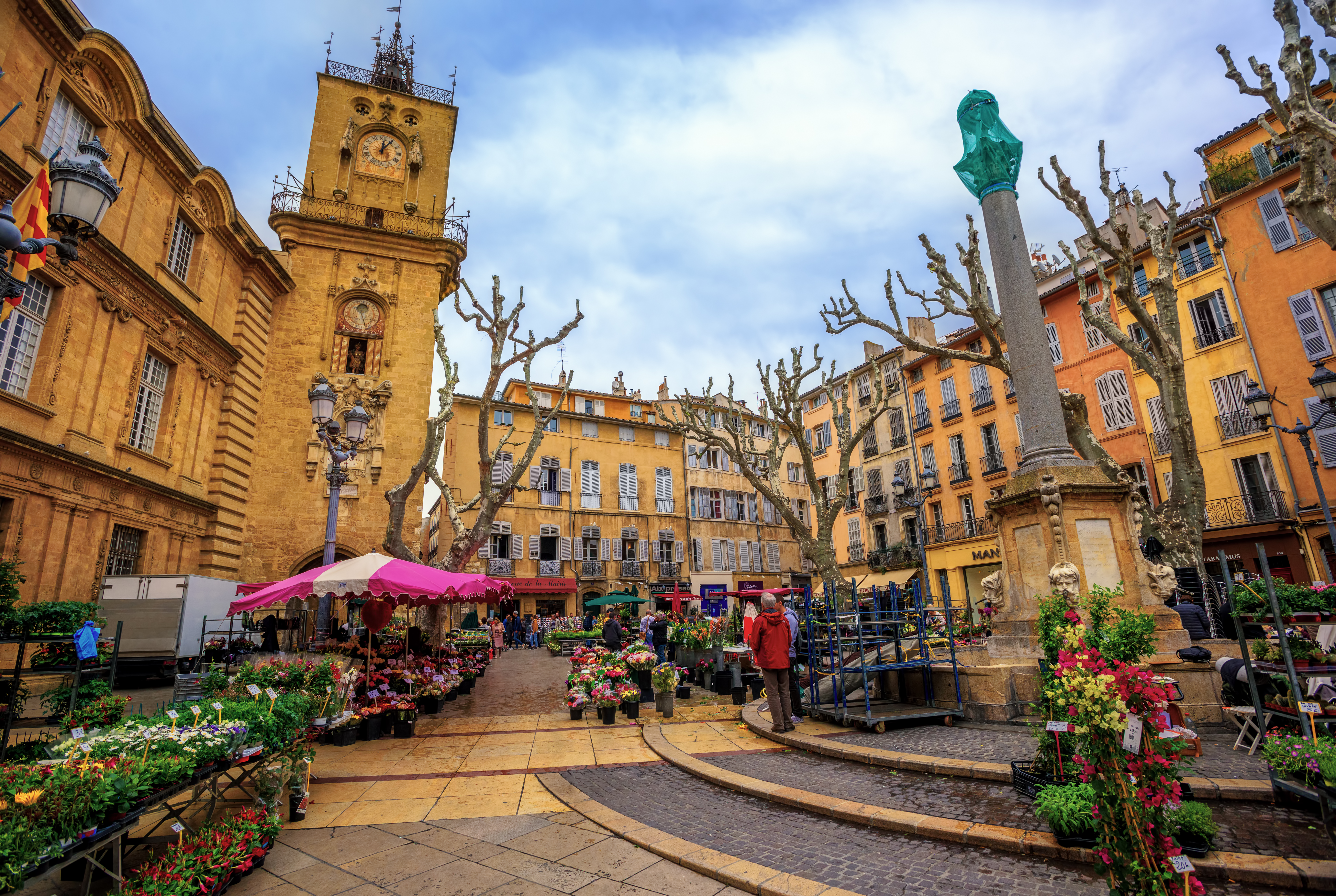
Aix En-Provence
In contrast to the many villages/hill towns of the Provence countryside, Aix-en-Provence seems like a big city (although its population is only 145,000). Perhaps our favorite artsy city in Southern France, Aix has the feel of the Left Bank in Paris, with its chic, leafy boulevards and public squares lined with 17th/18th-century mansions. A walk down Cours Mirabeau is a relaxing, fun experience here. The lush, green boulevard is quintessentially Aix—great people-watching, many shops/cafes, and many beautifully designed fountains! Aix’s history is also quite compelling. This is where Roman forces enslaved the inhabitants of the Liguarium Celtic stronghold of Entremont. Another must-see stop is the Musee-Atelier de Paul Cezanne—it was here that Cezanne painted some of his most well-known works.
Arles
Located directly against the Rhône River, Arles is actually the largest city in France (293 sq. miles), most famous as a highly inspirational location for Vincent Van Gogh’s painting. With the abundance of boutique BNB’s and 5-star hotels (compared to other Provencial towns), Arles is fast becoming an international artist’s paradise, playing host to the Fondation Vincent Van Gogh (Van Gogh Museum), several galleries, and the annual Rencontres Internationales de la Photographie (the international photography festival founded here in 1920). Listed as UNESCO World Heritage sites since 1981, some of the Roman and Romanesque Monuments of Arles date back to as early as the 4th-century B.C. and include the Arles Amphitheatre (still in use for events today) and the Akyscamps (one of the most famous Roman necropolises, recently used as the location for a Gucci fashion show, and where Van Gogh and Gauguin painted together in the late 19th-century), among others.
Just outside Arles, we fell an excursion to Camargue Reserve is well worth at least a half-day. With over 32,000 acres of wetlands, this is a beautiful place to take a guided horseback ride, the preferred mode of transportation for locals.
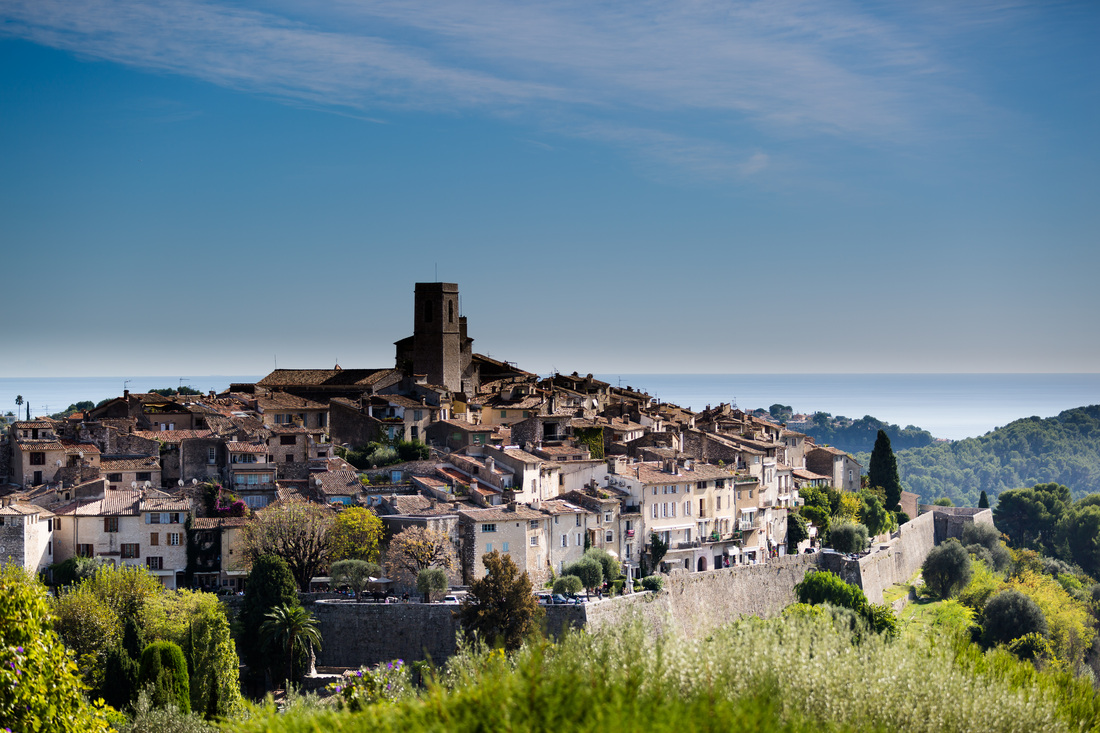
Grasse
Referred to by many as the “California of Europe,” the town of Grasse is more than a unique excursion from Antibes/Hôtel du Cap. For 500 years, this relatively small hilltop town of approximately 53,000 has remained the center of the worldwide perfume hub.
A few of the perfumes made in Grasse include Caligna by L’Artisan Parfumer, VJK Vatnajökull by Gydja, Atropa Belladonna by Shay & Blue, Jour d’Hermès by Hermès, Rose 31 by Le Labo, and Rose des Vents by Louis Vuitton.
Sheltered from sea air, the town’s confluence of soil, sun, and temperature nurtured the rose, jasmine, lavender, myrtle, and wild mimosa that were the genesis of the French perfume industry in the 17th century. Grasse is especially known for its fragrant May rose, the pale pink flower that blooms in May. While May through June is the best time to visit for the rose blooms, the summer, September is also an ideal time to catch jasmine at its peak.
The short version of Grasse’s place in the history of perfume begins with a foul odor. In medieval times, the town had a thriving leather business, but the tanning process made for pungent merchandise that didn’t sit well with the gloved nobility. A Grasse tanner presented a pair of scented leather gloves to Catherine de Medici, the queen of France from 1547 until 1559, and an industry was born.
To this day, in and around Grasse, Dior, Hermès, and Chanel all grow May roses and jasmine in protected flower fields. Every year, Grasse exuberantly celebrates both of these fragrant blossoms with two festivals, and just this year Dior re-established the famous Château de la Colle Noire, Christian Dior’s former residence in Grasse. Louis Vuitton’s Rose des Vents is the most emblematic of the fragrant flowers of Grasse, as described by perfumer, Jacques Cavallier Belletrud. Belletrud, partnering with the Louis Vuitton and Christian Dior fashion houses, opened a perfumery housed on an 18th-century estate to cultivate 450 different plants to create Louis Vuitton and Dior’s high-end, layered scents.
Many renowned “noses” (or perfumers) work and pull inspiration from Grasse. The town is so associated with perfume, its history, and the skill involved in making it, that industry locals have applied for a place on UNESCO’s Intangible Cultural Heritage list, an inventory of traditions that rely on a wealth of transmittable knowledge that could be considered fragile in an increasingly globalized world.
For a comprehensive overview of the history of perfume and its origins in Grasse, visit the International Perfume Museum, which holds a collection of old bottles of perfume, oils, and an array of flowers – tuberose, lavender, and jasmine.
Eze
Eze is named for the goddess, Isis, whose cult was supposedly worshipped in this place during the pagan era. Rising 1400 feet above the sea, the view from this idyllic place is truly breathtaking. During our last visit here, the sweet fragrance of thyme, wild rosemary, and Aleppo pines filled the air. Compared to Nice or Monaco, Eze is a peaceful, sleepy community with an understated sense of luxury, where you will see jet-setters stopping in and out for lunch via the pebbled Papaya Beach. The village of Eze is well preserved, with small stone houses, and many quiet art galleries, cafes, and shops set among the winding roads. Although a bit arduous, we recommend a visit up (via steep streets) to the old chateau ruins and the quite spectacular Jardin d’Eze.
Joucas
Built on a hill across from Roussillon is the quiet and less visited village of Joucas. Here you can stroll the narrow streets paved with ancient stones or take advantage of the many walking trails offered. A stopping point is the seemingly nondescript 18th century church that transforms into a museum of Italian painting, particularly the trompe l’oeil style, once inside.
L’Ise-sur-la Sorgue
We found this small medieval town along the serene Sorgue River to be quite unique. You will see many working “water-wells” along the river with quaint water-side cafes and shops. Though well-known for its flea market, L’Isle-sur-la Sorgue is also noteworthy for its high-quality antique shops and hosts antique markets on most Sundays. Among the shops frequented by our clients are Stéphane Broutin, La Boutique de Francine and Objets de Hasard.
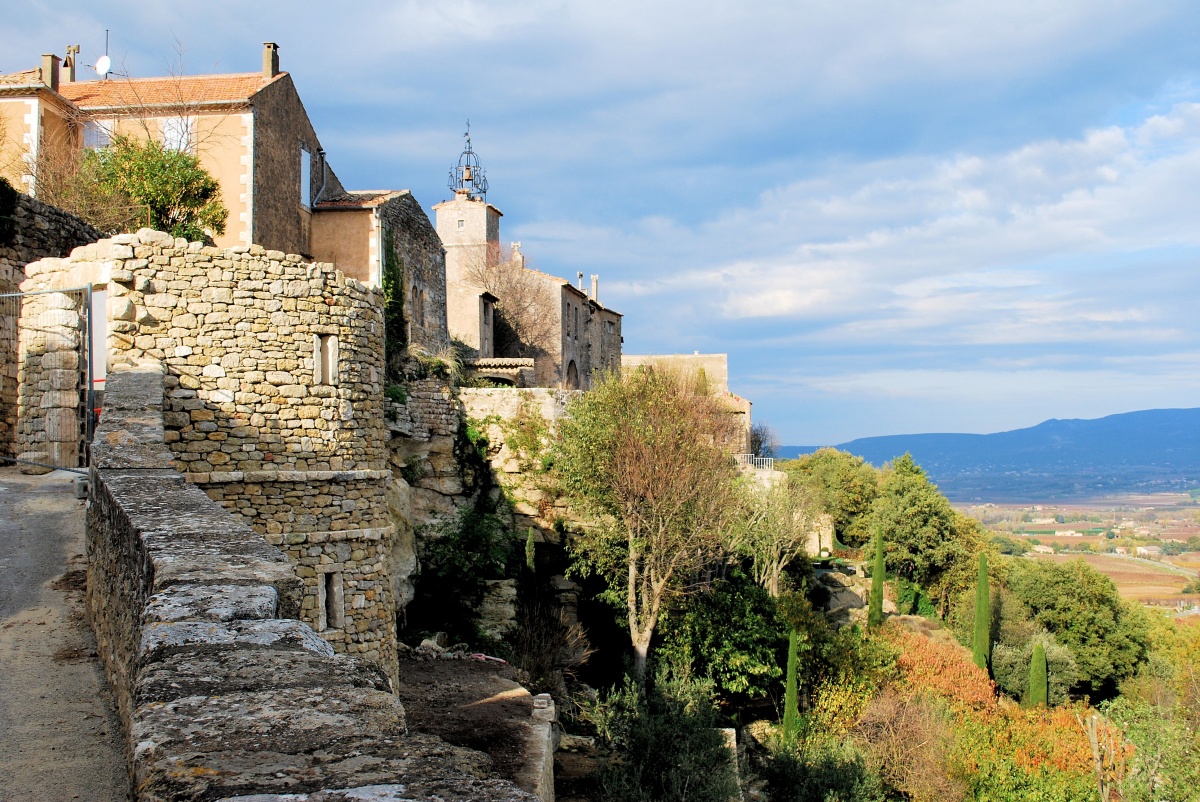
Menerbes (added bonus – a stay at the luxury boutique La Bastide de Marie)
During our first visit to the picturesque village of Ménerbes (population 967), we had the very best thin-crust pizza of our lives! Known as a “perched village” in the center of the Luberon region of Provence, Ménerbes is similar to much of the Luberon area’s “hill villages”. Author Peter Mayle wrote his best-selling book “A Year in Provence” while living here. Ménerbes is moored in a picturesque hilltop, accessible by scaling steep local streets—we feel well worth the effort! Do not miss the village’s 12th century church, somewhat concealed among the maze of narrow streets.
St. Paul de Vence
One of the oldest medieval (and artsy!) towns in the French Rivera, Vence is our favorite escape excursion from the glitter/pretentiousness of Antibes/Nice. Home to both Chagall and Picasso, the cobbled, narrow streets here are full of wonderful galleries, restaurants, and museums. Recent clients felt that dining at the famous La Colombe d’Or restaurant was a big highlight of their visit here. The restaurant occupies a rose-stone renaissance mansion with a remarkable array of famous artists’ paintings adorning the walls—Picasso, Chagall, even doodles by Charlie Chaplin! Many impoverished artists of the time paid for their meals with their creations. As a result, La Colombe d’Or has perhaps the largest private art collection in all of France. You may see as many celebrities dining here as staying at the Hôtel du Cap!
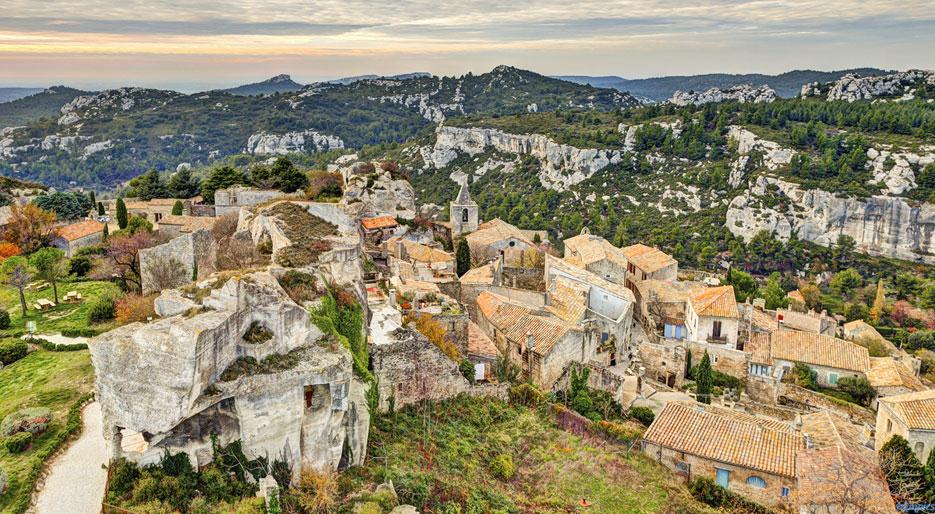
St. Remy
Originally known for its most famous son, Nostradamus, St-Remy has become one of the area’s most chic destinations for its wide selection of high-quality restaurants and gourmet shops. Being Roman history buffs we particularly enjoy the Roman sacred site Glanum, just outside the city. Dating back to the 3rd century BC, this archeological site is especially known for its well-preserved Roman monuments of the 1st century BC, “les Antiques”, a mausoleum, and the oldest triumphal arch in France.
Two of our favorite stopovers here are Joel Durand Chocolatier (on the city’s main boulevard, considered one of the top 10 chocolatiers in France!) and Le Bistrot Du Paradou (a small bistro 15 min outside the city with a cult following dating back to the 1980s).
HOTELS
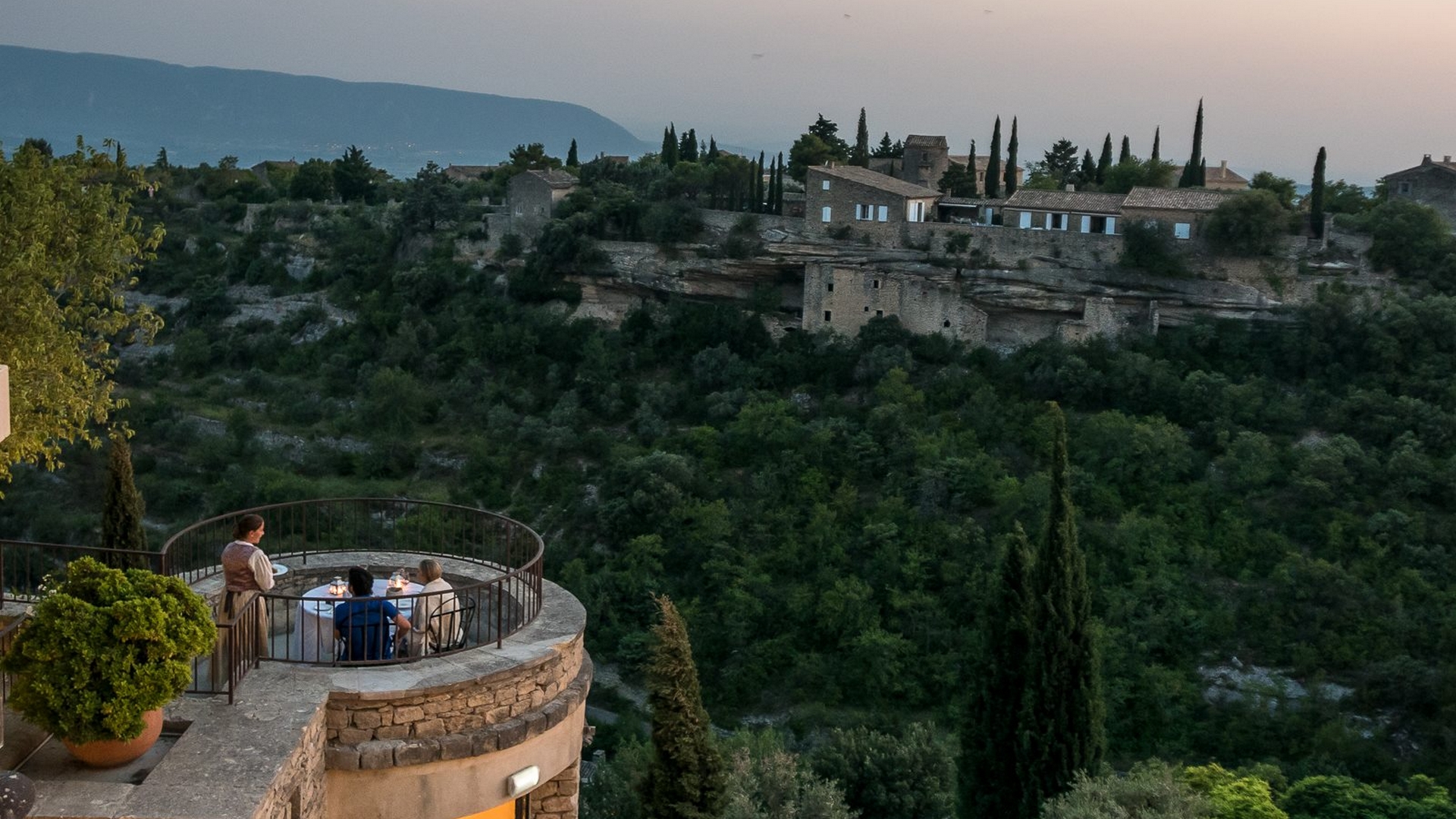
La Bastide de Gordes
Regarded by some as the “exquisite jewel in Gordes’ crown”, this renowned 16th-century property sits at the top of narrow village streets in the town of Gordes. This Airelles property comprises sun-bleached stone and hanging gardens overlooking the Luberon Valley. The property’s 40 guest rooms, three with private terraces, are rich in history, adorned with some of the over 4,000 pieces of art sourced from France, Italy, and Switzerland that can be found throughout the property. The best place to spend a hot summer day is at the hotel’s famous cerulean pool from which you get panoramic views of the Alpilles mountains. For dinner, guests can request to be seated at a single round table on a turret jutting out over the valley.
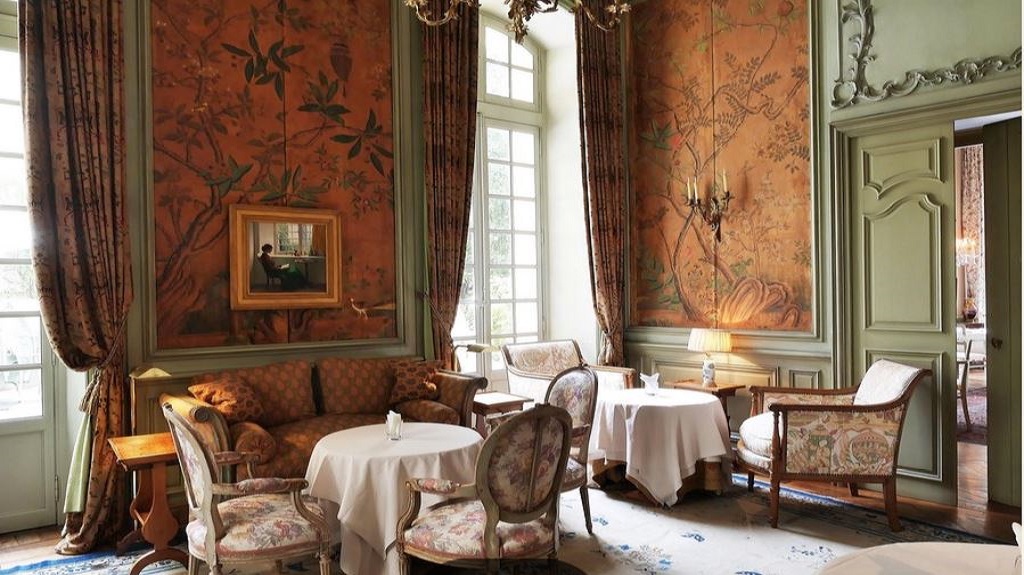
La Mirande
Located in a national historical monument building, formerly the residence of a 14th-century cardinal, La Mirande is set in an ideal location inside the walled section of Avignon, across from the medieval “Palace of Popes” complex. With just 26 rooms, special care was followed during the property’s refurbishing, featuring painted wood-paneled walls with tapestries, antique glass windows, and vintage oak parquet floors We particularly like the hotel’s garden dining terrace and courtyard conservatory for afternoon tea. Being avid Japan-enthusiasts, we were surprised to see they have Kukicha and Gyokuro tea options! Of special note for our “foodie” friends, La Mirande’s restaurant dining experience offers a gastronomic menu featuring organic, farm-raised products taking to heart the words “seasonal” and “terroir”! The restaurant’s Le Marmiton cooking class is noteworthy among chefs throughout Provence. With its charming, relaxing atmosphere and personal, singular service, we feel a stay at Le Mirande is a special and memorable experience to enhance your private tour of Provence.
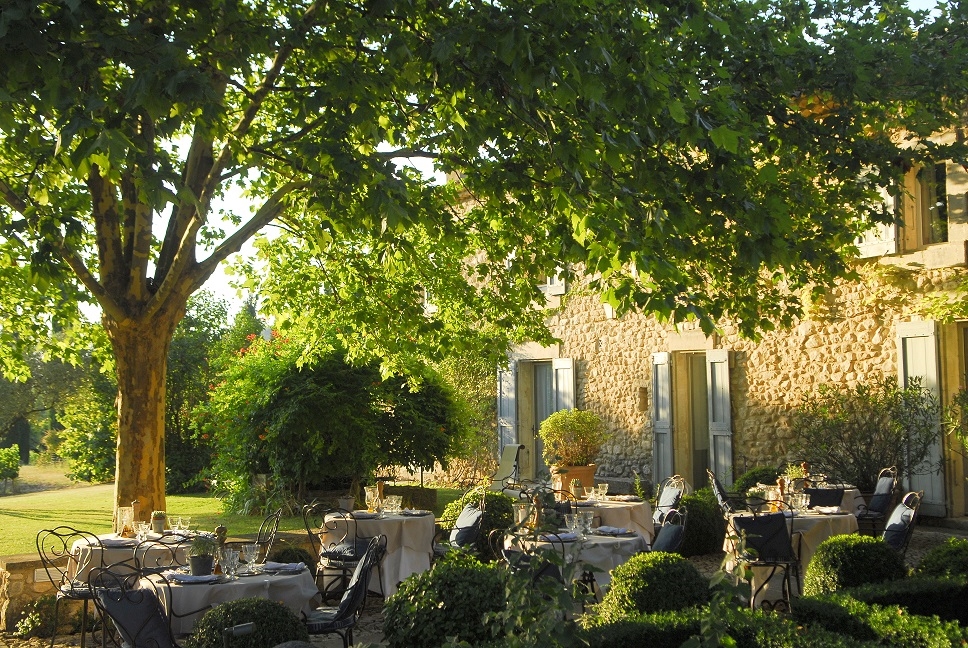
La Bastide de Marie
Bev, Zen, and I discovered the lovely La Bastide de Marie during our recent summer travel to Provence. This is an absolutely charming 16-room luxury boutique property, converted from a group of 18th-century farmhouses. The rooms are made from exposed stone with beautifully decorated fine fabrics. The Dining Room here has picturesque views from a terrace overlooking its own vineyard. You are served rich, inventive dishes from local produce, inclusive of breakfast, lunch, and dinner.
We particularly enjoyed the idyllic 24 hectares of vineyards surrounding the property, in addition to a very nice, aesthetically pleasing pool. This is a truly heavenly place for couples and families alike—we feel La Bastide de Marie represents the essence of Provence.
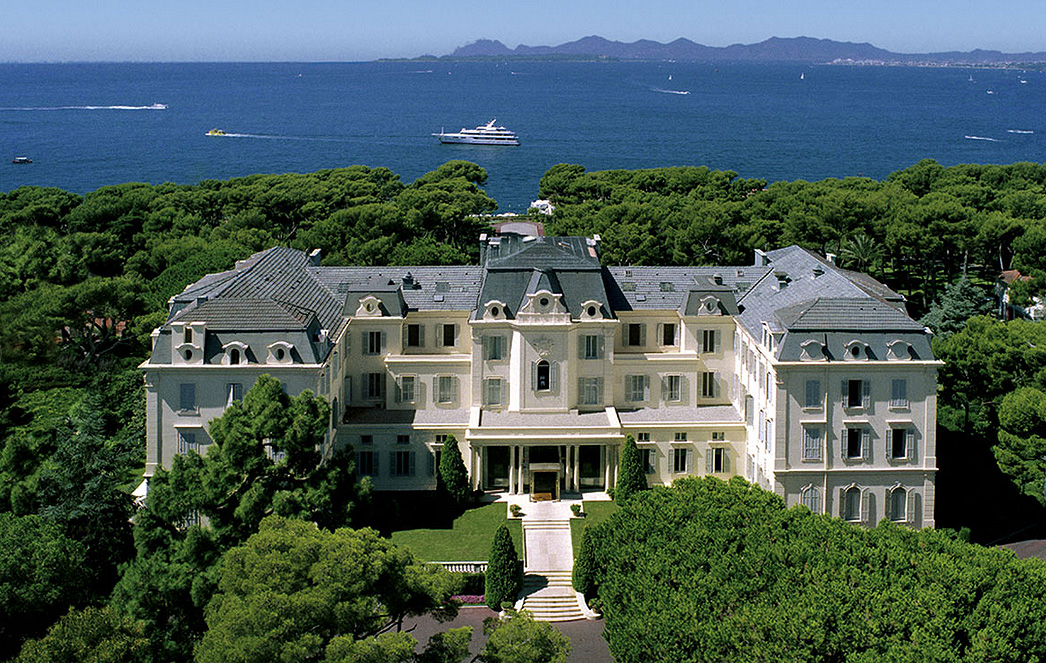
Hôtel Du Cap
Many believe the Hôtel du Cap to be the most sought-after summer retreat in the world, and our clients would agree. Yes, the Hotel du Cap is expensive, pretentious, home to global celebrities/jet-setters, and among the most beautiful hotels we have stayed anywhere in the world! Despite the 55 Euro cost of a cheeseburger at the Eden Roc pool grill; our Lynch family has fond memories of our last stay here. Located in Antibes, Hotel du Cap is 45 minutes to an hour away from St. Jean Cap Ferrat, which is just on the other side of Nice. The reputation of Hôtel du Cap is maintained in part because of its idyllic location but perhaps, more significantly, due to its reputation for high-touch, understated service. Owner/proprietress Maya Oetker personally decorates each of the 118 rooms and has maintained a level of excellence that is unimaginable, even by 5-star luxury hotel standards.
Please note brief observations from our last family stay:
- GM Philippe is a man of details and it shows in the high-touch service here – nearly everyone on the Hotel du Cap property addressed Bev, Zen, Sofia, Coco and I by our names (extraordinary for a 118-room hotel!) and you can actually summon the room service staff by using a bell alongside your bed – quite amusing for the girls!
- We were all big fans of the sunbathing pontoons off the Eden-Roc pool and the super snooty cabanas! (33 in total).
- Although the Eden-Roc infinity pool adjacent to the waters of the Cap d’Antibes is quite spectacular, please note this is a saltwater pool.
- There truly is a distinctive Hotel du Cap scent. The intoxicating fragrant smell that permeates the halls and rooms of the property is heavenly.
- A central feature of Hotel du Cap is its expansive 22 acres of lush, green grounds, including rose gardens and clay tennis courts…great for morning walks and tadpole catching in the lily pond!
- Breakfast or evening cocktails on the Bellini terrace—it is difficult to imagine a more picturesque setting overlooking the warm waters of the Mediterranean!
- Surprising to see the hotel has its own pet cemetery…Edward VIII’s and Wallis Simpson’s dogs were buried here.
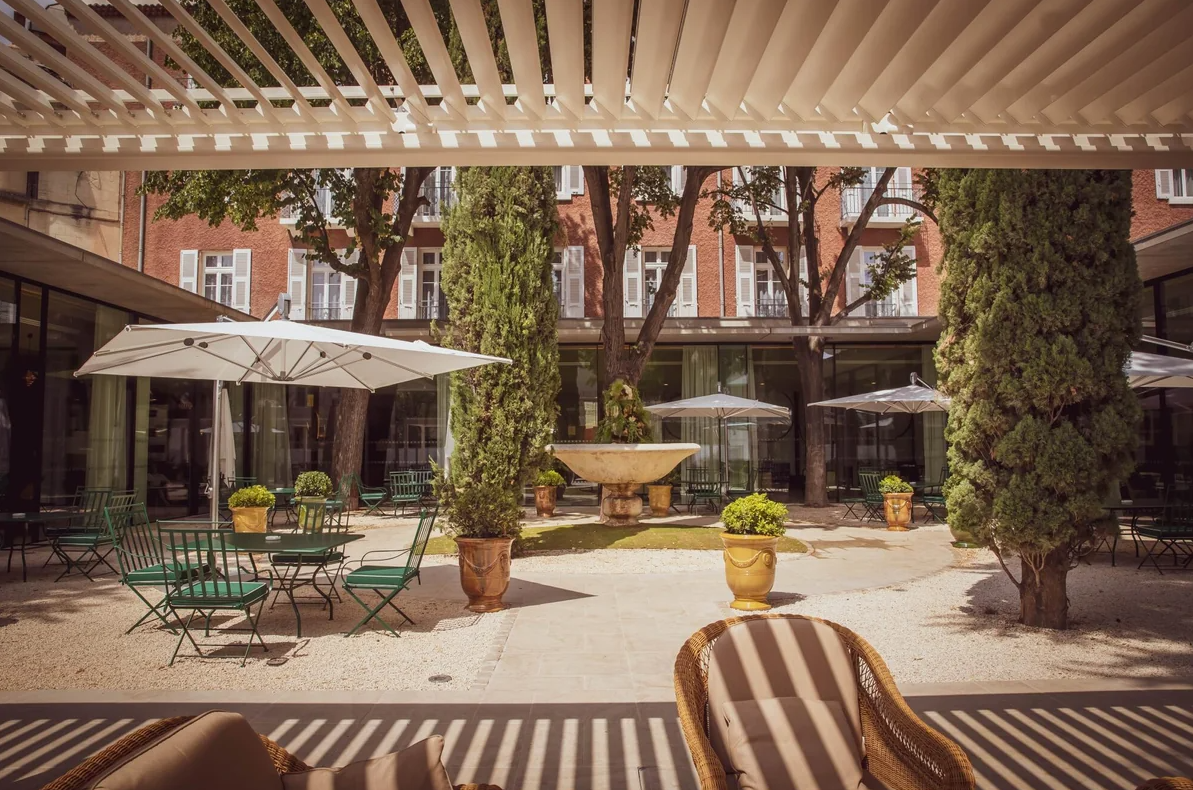
L’Imperator
Newly renovated urban retreat, La Maison Albar Hotels – L’Imperator in Nimes France is located in a 1929 vintage building with 53 rooms/suites offering a mix of contemporary wood, marble, and stone decor. The likes of Ava Gardner, Frank Sinatra, and Ernest Hemingway have enjoyed this Provençal retreat. 3 Michelin Star Chef, Pierre Gagnaire offers guests creative and gourmet cuisine at the onsite gourmet restaurant Duende, the brasserie L’Impé, and the Bar Hemingway. The property has both indoor and outdoor pools, Codage Spa, a fitness center, and a 10,000 sq. ft. garden. If staying here during bullfighting season, late April through September, you will be able to experience festivals in Nimes’ historic amphitheater.

L’Arlatan
Redesigned by Cuban American artist Jorge Pardo, the 34-room L’Arlatan re-opened in October 2018 in the Provencal town of Arles. This boutique hotel is located in a 15th century stone mansion, the former home of the Counts of Arlatan de Beaumont. Owner Maja Hoffman gave Jorge carte blanche to re-design. Dating back to the Middle Ages, L’Arlatan is considered Arles’ most lavish hotel, an impeccable 64,000 square feet of mosaic now adorns the hotel with an explosion of color, light, and contemporary design!
The hotel is comprised of several buildings, the central, listed as a monumental historical area, is set around a courtyard with majestic stairs and lounges. Michelin starred Chef Armand Arnal leads the onsite restaurant where the cuisine emphasizes vegetables and fish, quintessentially French. Amenities include a cocktail bar, pool, garden & courtyard.
Hoffman is also the founder of a foundation behind the Parc des Ateliers project which is transforming a former railway yard into an arts campus.
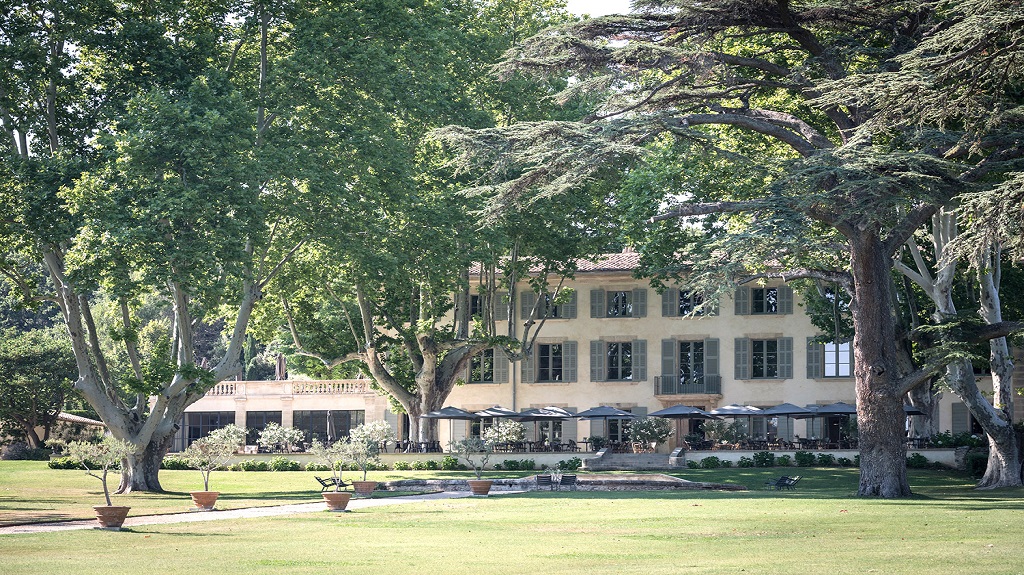
Domaine de Fontenille
Located in Luberon Regional Natural Park, Domaine de Fontenille is found at the heart of an exceptional wine estate. Converted into a luxury hotel by designer Alexander La Fourcade, the 19-room property boasts views of the Durance Valley. La Fourcade has been a restorer of historic properties since 1988 when he joined his father’s business and handled residential restorations from Narbonne to Monaco until 1998 when the company took on its first hotel clients. Most recently, he has been working on several winery projects around Provence.
Each room at Domaine de Fontenille is unique, however, they are all bright with blended classic and contemporary styles that exude a refined yet discreet luxurious environment. Most rooms face south towards the Luberon Hills. There are three restaurants onsite including Michelin-starred Le Champ des Lunes. For wine lovers, The Domain has been creating certified organic wine since 2014. The grounds of the property have eco-gardens for those wishing to learn more about farming practices focused on conversation or just simply looking for a peaceful walk. Our active clients can enjoy walking vineyard trails, visiting the gym, horseback riding in the Luberon valleys and mountains, or swimming in the heated pool. The property also has a full-service spa.
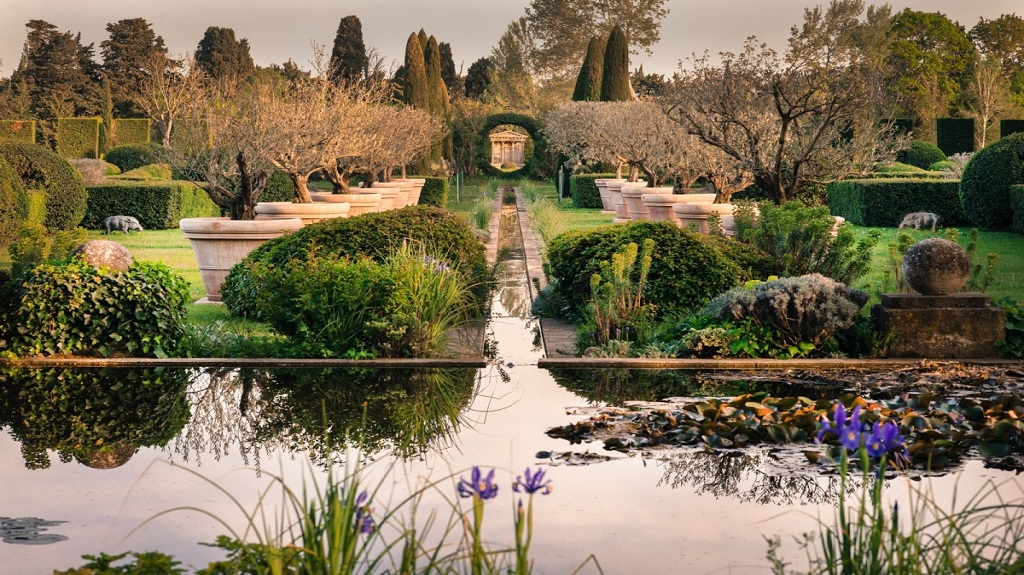
Les Confines Private Villa and Gardens
Les Confines is the perfect option for our multi-generational family clients looking to spend quality time in a pristine and stunning Provencal location. The house and gardens are set on their own twenty-acre estate. This 10-bedroom villa can host up to 18 people including children and is secluded but just a short drive away from St. Remy-de-Provence and within half an hour from Avignon, Arles, and L’isle sur-la-Sorgue. Famous for its many gardens from the African to the Portuguese and Ball Garden, each has its own feel and has been designed with a particular theme in mind. Created by the much-fêted landscape gardener Dominique Lafourcade, the gardens of Les Confines have been lauded in numerous publications and have inspired many designers all over the world with their beauty. Aside from the formal gardens, there are two swimming pools, outdoor dining areas, a multi-purpose tennis court, available bicycles, and a large playground filled with options for children. Les Confines is the perfect place to relax and enjoy after a day of exploring the villages of Provence.